How to visit a national park that’s bicycle friendly – bicycle obsessed, in fact – with a service dog and a kid who’s averse to the tippiness of regular bikes? In the Netherlands this isn’t a problem: a cargo bike for Ethan the dog, a tricycle with lounge seating out front for Oliver.
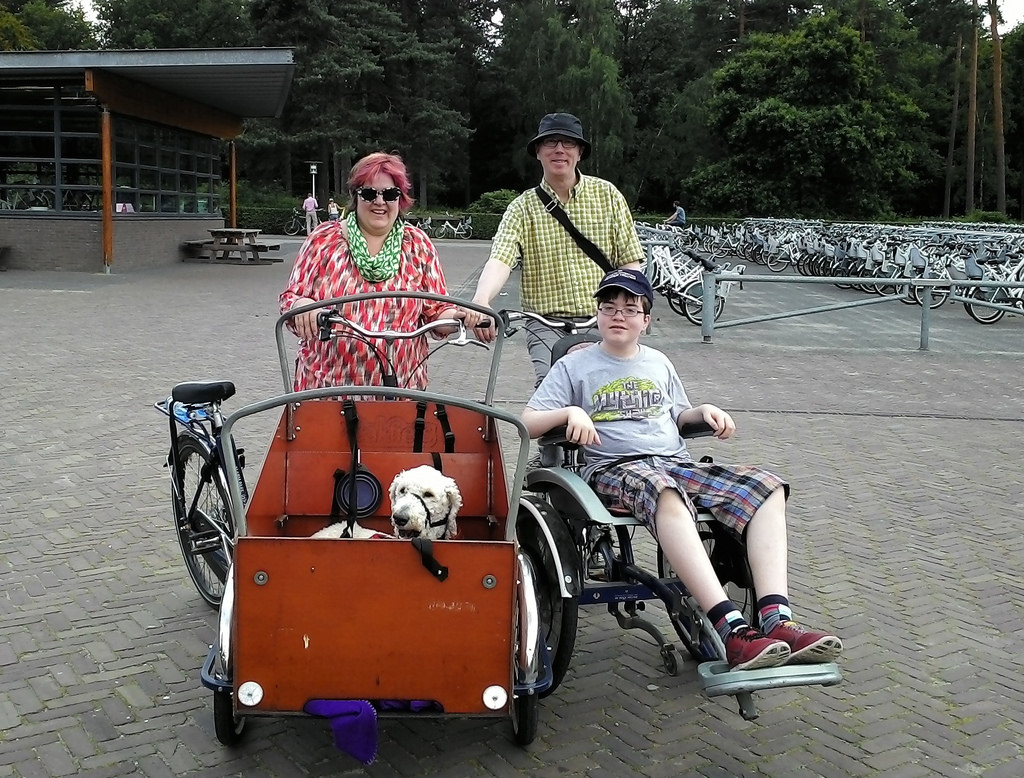
The dedication to cycling accessibility in this part is truly something behold. We had a great day out on the trail, rambling about in the reconstructed wilderness of De Hoge Veluwe National Park.
Careful readers will see that I’ve entered the On Golden Pond phase of my life.
Every summer when we were kids my father would go “in the field.” We assumed, I think, that every father did this, so it didn’t seem unusual: for him it meant going to a different spot on one of the Great Lakes every summer to do field work for his job as a near shore sedimentologist. Often we got to go along for at least part of the summer; indeed we watched the Moon landing on a tiny black and white television set in a VW microbus on the shore of some lake or another.
As I type I am sitting aside my own VW microbus. My “own” in the sense that we’ve rented it for 2 weeks for a tour of the Netherlands
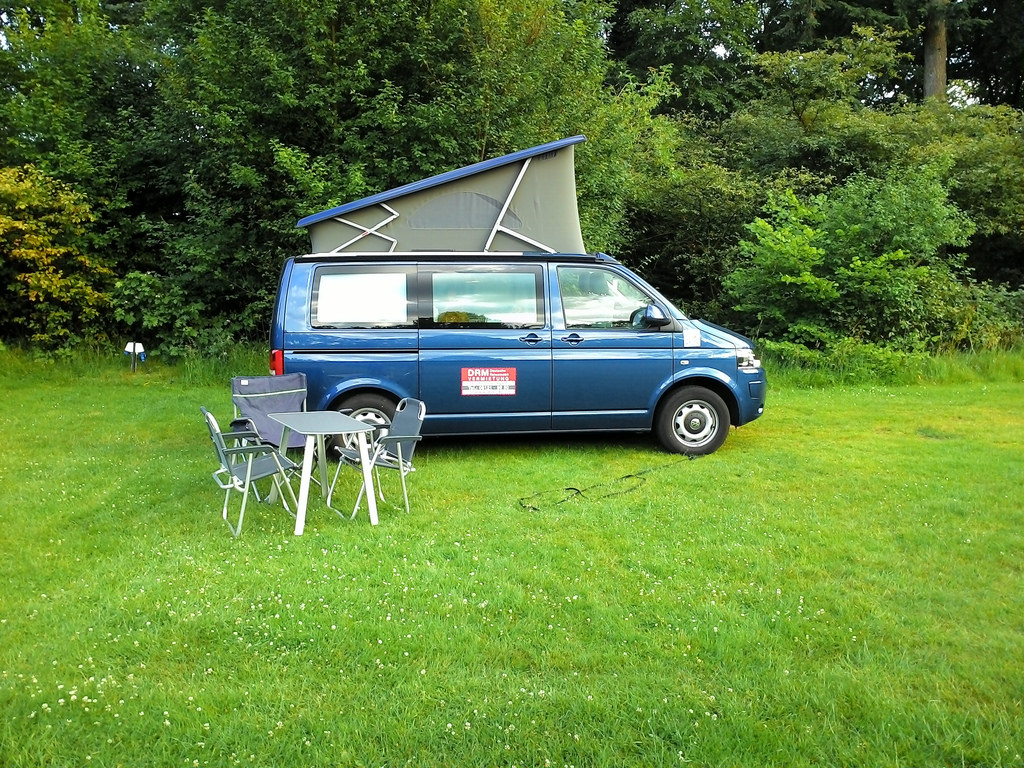
I too am in the field, but in this case simply because I actually am sitting in a field, in campsite “Natuurcamping De Hoge Veluwe” that’s part of the De Hoge Veluwe National Park in the middle of the country. The view from my chair looks like this:
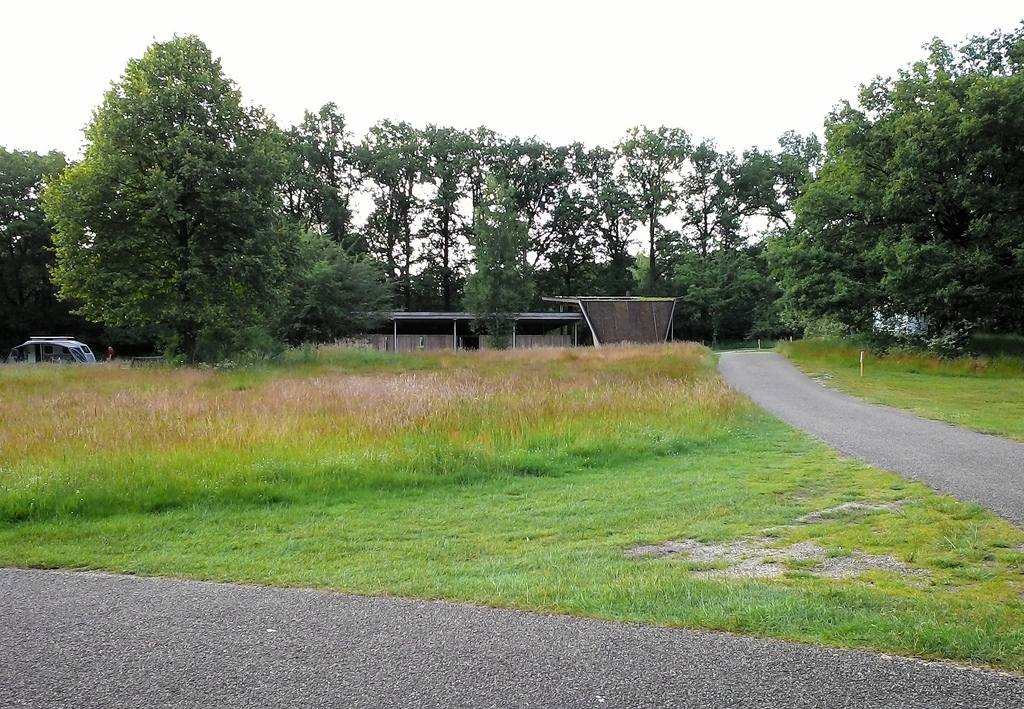
That the “sanitary station” you see in the distance, an ecologically-designed place to shower and wash dishes and ablute. It has a green roof. And a free lending library. Oh, and there’s wifi, provided as part of the site rental along with electricity.
We arrived here late this afternoon after spending a pleasant day slightly to the north in the town of Meppel. Last night we camped between a highway and a canal; we cooked breakfast and then headed into town for a lunch with Bill Whelan and Michelle Coutreau, Islanders who, as it happens, are also touring the Netherlands by VW microbus this June (this required, as you might imagine, a rendezvous: how could we not!).
We spent the afternoon at the Drukkerijmuseum Meppel, the nicest little printing museum you ever did see. Where Oliver was taken under the wing of a kindly Dutch printer who guided him through the process of making paper, setting type, and printing:
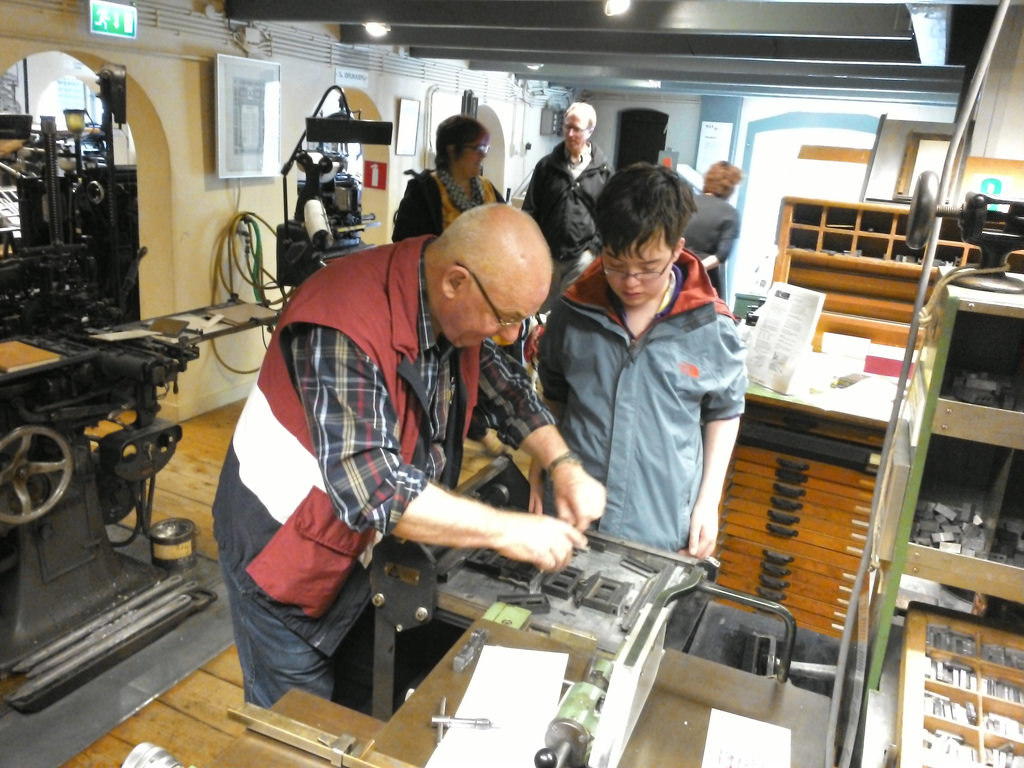
We even got a demonstration of an Intertype machine (cousin of the Linotype), the most marvelous of marvelous machines:
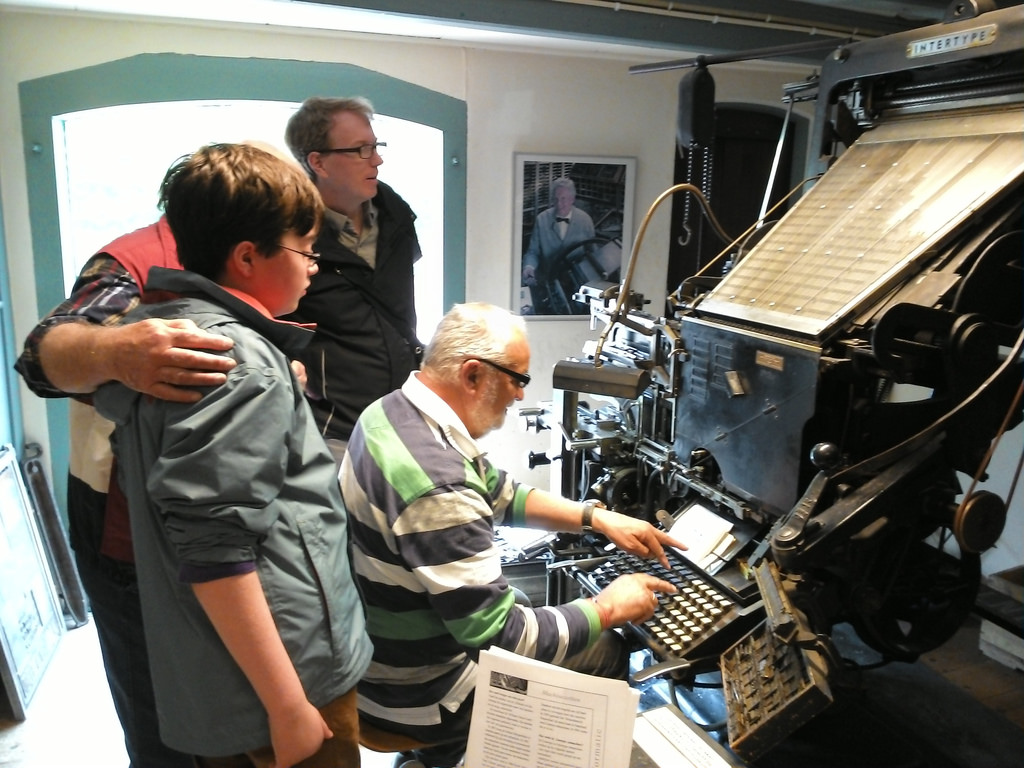
Oliver has a slug of “Oliver Rukavina” burning a hole in his pocket, which is sure to attract the eye of airport security, or at least public health, as we make our way home.
Hoge Veluwe seems like a truly magical place: the campground is more wildernessy that others we’ve stayed at (something that Catherine, who has seen real wilderness, would dispute if she was reading over my shoulder, and that the presence of wifi would seem to contradict). There is a fleet of freely-borrowable white bicycles at the entrance and visitors are encouraged to leave their cars at the gate and bicycle about. Our plan for tomorrow is to borrow a tandem bike for Catherine and Oliver, and a cargo bike for Ethan and I, and do our own tour about.
Oh, and did I mention that in addition to all the wilderness, there’s also a museum on the grounds filled with works by Seurat, Picasso, Leger, Mondrian and others? So maybe it’s not wilderness at all.
We’ll likely stay another night so as to be able to take advantage of the twilight “Wandelen of fietsen naar een wildobservatieplaats” after supper.
And then it’s on to… not sure yet. One of the great things about being in the field – at least this one – is that there are no plans.
We made our way from Düsseldorf to Enschede, just across the Dutch-German border, on Thursday and settled in at Stadscamping de Twentse Es, which turned out to be a friendly campground with lots of bandwidth and a lot of rabbits.
A lot of rabbits.
For Ethan this proved a frustrating novelty, at least for the first few hours. Rabbit! Oh, rabbit! Rabbit! Then the novelty wore off, and now he hardly notices the rabbits at all.
With our bones still tired, and the scheduled start time of Make Stuff that Matters (our nominal reason for being here) set for 9:00 a.m., we decided to cook dinner, then get to bed early.
We did not do that.
Well, we cooked dinner – Catherine make a nice salad with fresh strawberries – but then I recalled that Oliver and I were due to deliver a talk on Printcraft, that “make stuff in Minecraft, print out on a 3D printer” technology that’s simply delightful. So we rallied, came up with a practical need – a dispenser for the rolls of blue dog poop bags that were unravelling around the camper – and set to work on a design. Without a ruler, we were left to use a ruled notebook as a proxy: we measured things out, figured out where the bags would come out and how we could make a slotted lid. We ended up with this:
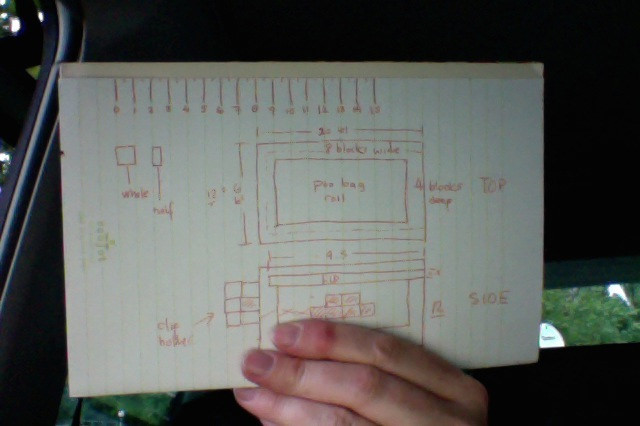
We then set to work building our model inside the Printcraft world, staying up far too late for our own good. When bedtime was finally upon us, we had this:
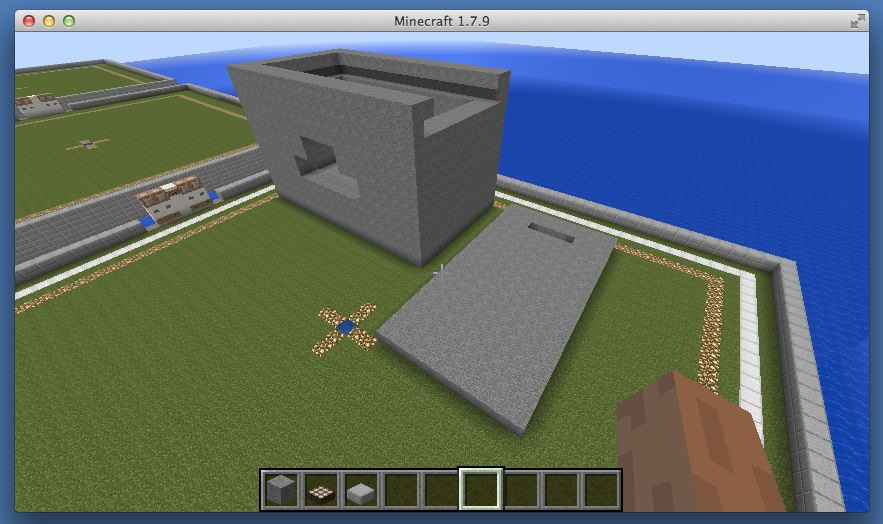
The basic idea was to build a box that was “roll of poop bag”-sized, with a slot in the top for a sliding lid, and an outlet on the side where a single poop bag could be extracted. Oliver “walked” over to the Printcraft control panel, and hit it:
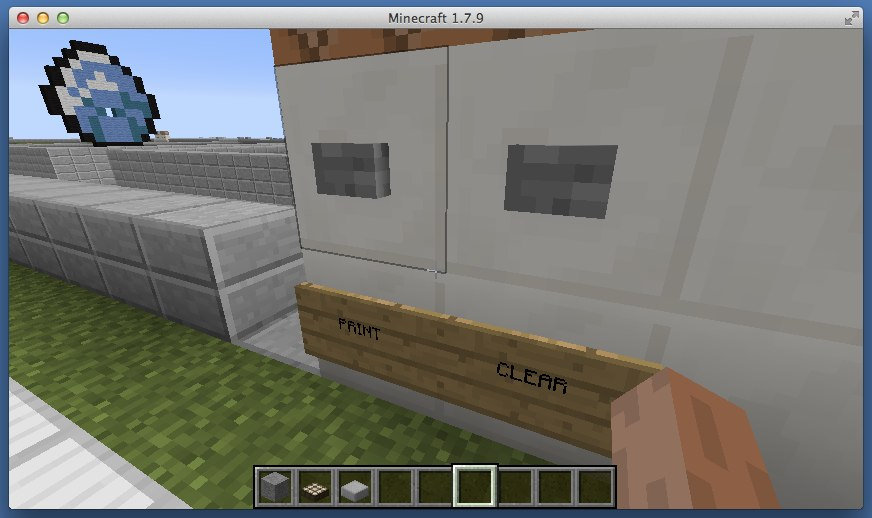
This generated an STL file – the lingua franca of 3D printing. We were ready for analog.
The next morning at Make Stuff that Matters at Ton and Elmine’s house, with Elmine pointing the way, we installed Cura, the app from Ultimaker (the brand of 3D printers in the house for the weekend) and converted this STL file into a G-code file required by the printer. We immediately realized that to print the box full-size was going to not only hog a 3D printer for much too long – 2 hours and 41 minutes was the estimate – but that were we to do so we’d not have the object in-hand for our demo in the afternoon. So we shrunk things down in Cura to 30% of full size, which took the print time estimate down to 19 minutes.
We put the G-code file on an SD card, put the SD card into the printer, selected the file and hit the “do it” button. Eighteen minutes later, we had a tiny poop bag box:
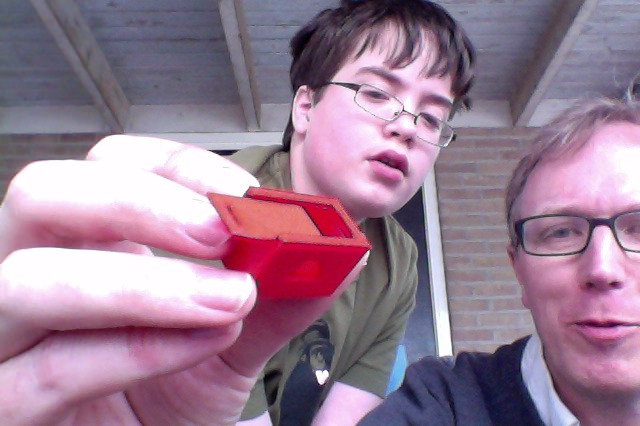
Truth be told, to allow the lid of the box to slide into the box required 10 minutes work of post-printing finessing with sandpaper and a pair of scissors (photo by Elmine Wijnia):
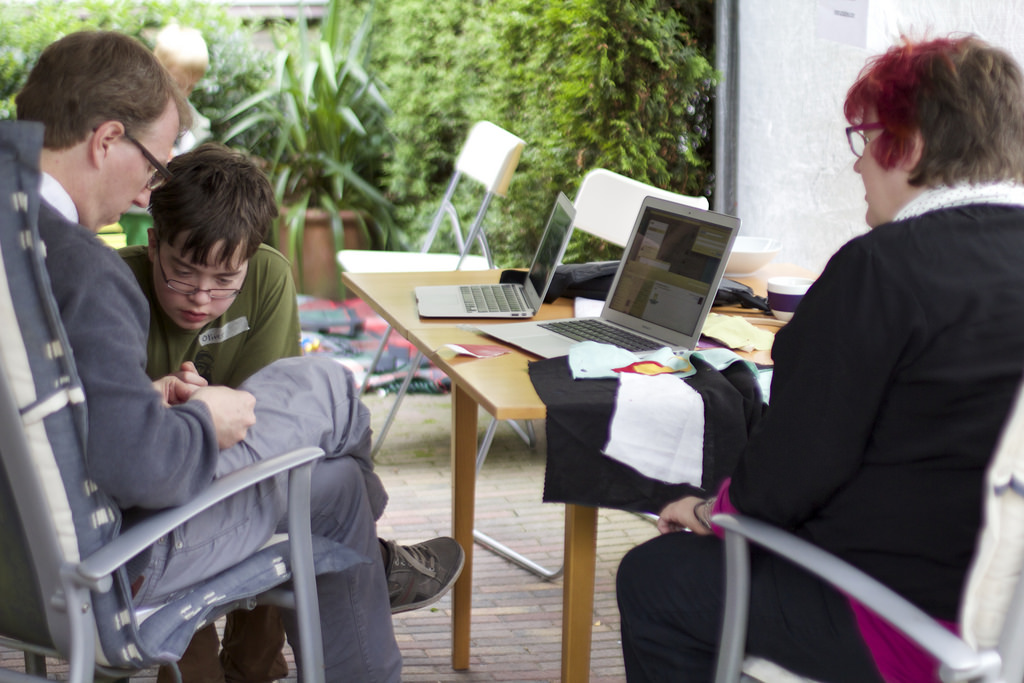
But it worked!
A few minutes later, Oliver and I were “on stage” in Elmine and Ton’s living room telling the story of the poop bag to a diverse group of interested people (photo by Elmine Wijnia):
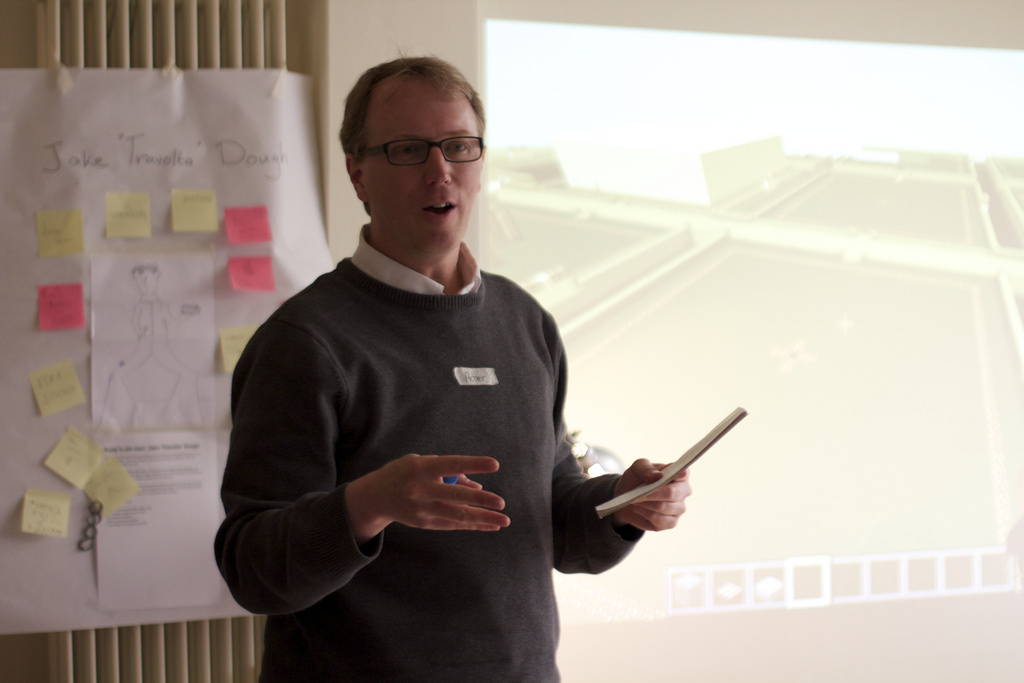
Among those people listening was a young lad named Floris, a Minecraft savant: our little presentation was enough to enable Floris to make an very detailed castle in Printcraft; on the screen it looked like this:

Once the castle was printed, it was just amazing (photo by Ton Zijlstra):
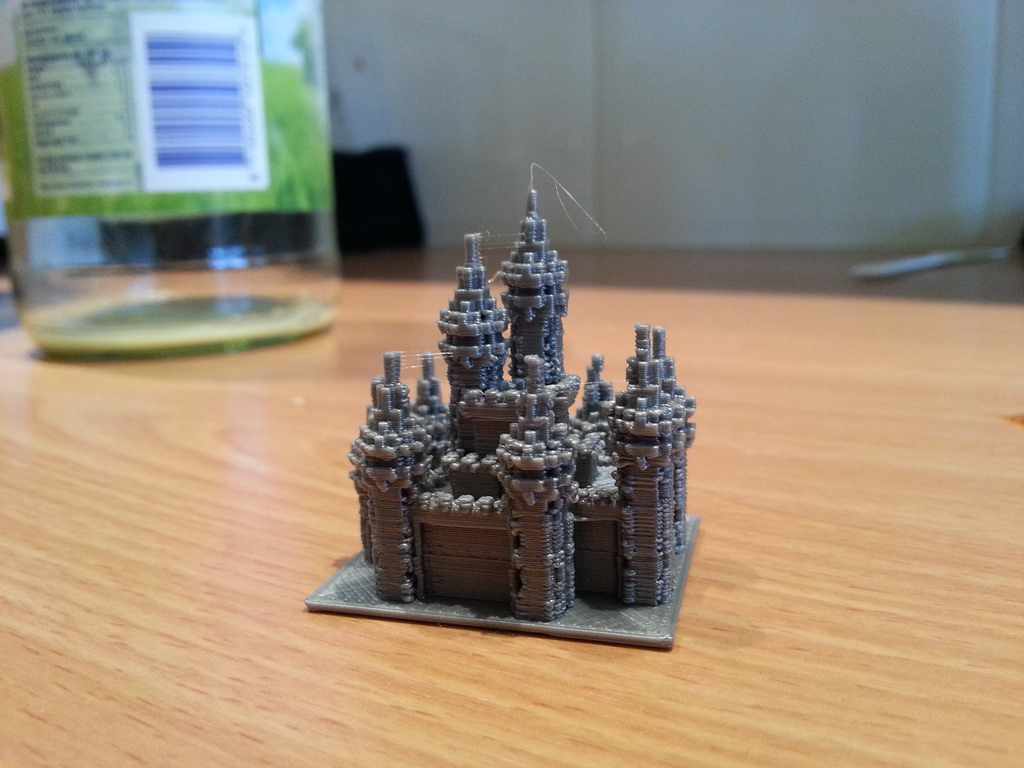
The level of detail was a testament to the painstaking effort Floris took in Printcraft, dropping each block where it needed to go.
The opening salvo in Ton’s scene-setting for Make Stuff that Matters was a suggestion that we come to look at “making” not as a solitary digital act commited behind a screen, but as a participatory act of community. The exercises that Ton and Elmine designed to nudge us to that point got us in that direction, but to really get Oliver and I there all it took was a few “all you need to do is to stick it on an SD card” answers for Floris and his dad – the free sharing of otherwise mystical incantations.
In the months leading up to this event I’ve been thinking a lot about what “matters,” parsed out of “stuff that matters.” As there is a lot of evidence to suggest that most of what comes out of 3D printers is little more that tchotchkes 3d-waste, I wondered whether you could truly create something that “mattered” in a setting like this.
What I came to realize – or, really, simply have reinforced – is that the “stuff that matters” is the process, not the product.
If, as a community of consumers, we can collaborate to understand more about our consumption, and more about the production of what we consume, and more about how we can effect, control, or drive that production, what we will have achieved is far more substantial than whatever comes out of a 3D printer.
But the great thing about 3D printers is that, in spanning the digital and the physical, offering the possibility of on-demand fabrication, and simply being something we can all stand around as magic appears to happen within, they can catalyze conversations about stuff that (actually) matters.
So we made a tiny poop bag box.
And made some new friends.
And had some revelations.
And passed on some knowledge.
And learned a lot more.
And had some fun.
That matters.
The thing you don’t realize about The Amazing Race is that while it might look simple to, say, “catch the bus to the heart of Rome, find a pushcart vendor selling cashews, buy a bag, and deliver it to the Vatican Library,” doing this while jet-lagged, brain-addled and on only a few hours of sleep is an entirely different prospect.
The prize at the end of our own amazing race that began Tuesday was not a Polaris Sea-Doo or an amazing trip for two to Cancun, but rather supper on the banks of the Rhine.
But I am getting ahead of myself.
We left Charlottetown at 1:00 p.m. on Tuesday and drove to Halifax, making good time and arriving 3 hours in advance of our flight. We parked the car at the Hilton, caught the shuttle to the airport, and found the Condor check-in desk.
Where we were told that our flight was delayed by two hours.
Oh well.
Condor had record of Ethan, made no fuss about his traveling in the cabin with us, and the only requirement was for us to sign a waiver, the contents of which I cannot recall now (perhaps “if your dog eats another passenger, it’s not on us” or something like that?).
We occupied our extra time with eating, drinking (at the pleasant-respite-from-the-airport-feeling Alt Hotel lobby cafeteria) and making merry in the nicely-appointed dog area (under the bridge to the parking lot: it really is a wonderful feature of the airport).
The plane boarded around 10:30 p.m. and, what with Ethan being in our charge, we got super-deluxe, take-the-back-way-in, board-even-before-the-children boarding privileges. What’s more, the purser, on seeing us trying to squeeze into the almost-no-room-for-Ethan economy class seats immediately upgraded us to “premium” economy. He did this quickly, and in an “of course we will do this” manner that made me fall in love with him instantly. And premium economy, by compare, was dreamy: Oliver and Ethan and I got three middle seats to ourself, so Ethan got a full underseat to call his own, and Catherine got the entire row behind us to herself. We even got one of the swanky “amenities kits” that I last remember receiving on a BOAC flight in 1972.
Ethan weathered the trans-Atlantic flight in fine form: he did what he was trained to do, which is to gamely and calmly stand by. He neither complained nor barked nor made a fuss nor tried to climb up on the seats nor did he eat any of the other passengers. He was a dream-dog.
We arrived in Frankfurt on-time and, all things considered, in pretty high spirits. We found our way to the next terminal over, found the Lufthansa check-in desk, got a boarding pass for Oliver which, mysteriously, they had been unable to print in Halifax, and addressed the “oh, he’s a service dog riding with you in the cabin!?” nature of Lufthansa’s electronic non-record of Ethan (it was handled quickly and efficiently and we were re-seated three-abreast rather than in different parts of the plane).
By 2:00 p.m. we were in Düsseldorf Airport looking for a place for Ethan, who had gamely held his bladder for the entire trip from Halifax, to pee. Patch of grass beside the parking lot located there was, as expected, much peeing to be had.
We flagged a taxi, handed over the the address of the DRM camper rental outfit south of town, and then enjoyed the little tour of the edges of the city, bearing witness to the devastation wrecked on the city a few weeks ago by a suddenly-arising “super cell” storm that uprooted what appeared to be every second tree.
Picking up the camper was easy: handed over driver’s license and credit card, signed a few forms, received a walk-around and guide to using the VW camper’s complex system of push buttons (raise the pop-up, turn on and off the fridge, etc.) We filled up the water tank. I figured out how not to stall the camper in 1st gear. And we were off.
On our own amazing race.
Goal: buy dog food, find a SIM card for my phone, get groceries, find our campsite.
The challenge: jetlag setting in, an unfamiliar vehicle, no maps nor GPS (a chicken-and-egg problem involving the SIM card), streets crowded with downed trees.
The dog food was easy: there was a Fressnapf outlet only a block away from DRM.
Dogfood in hand, we headed off to find the “real,-” (yes, that’s how it’s set) store that, the web told me, would be the get-everything-else-you-need store. Miracle of miracles, following only the rough “Turn right on Fredrichsomething” notes I’d taken in the airport the night before, we found our way.
We bought groceries, negotiated a thicket of mobile operator offerings with a helpful (though non-English-speaking) clerk, and even remembered to buy towels and get a Benadryl-like cream from the pharmacy across the hall.
Back into the van and the degree of difficulty went to 11: the simple-seeming directions I’d written down for this leg of the trip – grocery store to campsite – turned out to be some sort of abbreviated list of street names that the Google Maps directions app gave me rather than a detailed route. So what turned out to be a 30 km journey on all manner of different roads and tunnels boiled down to a list of streets and tunnels only loosely connected.
But wait, you might be saying, I had a SIM card now, and thus should have had a GPS to guide me.
Except that the one downside of the “all you can eat high-speed data for a month” SIM I purchased from Blau was that you had to be online to register and activate it. And so until I could get online some other way, I couldn’t get online from the van.
My ace in the hole was parsing Rheinbrücke, one of the random street names Google gave me, into “Rhein bridge.” I knew where the Rhine was, because my friend Pedro lives near it, and he also lives near the big highly-visible tower in the city, so putting all that together I came up with a plan: head for the tower, find the river, drive over it, and hope for the best.
It worked!
We got close enough to where we needed to go that the final street names on the list started to fade into view, and having a general notion from the name of the campsite – Rheincamping – that it too was on the river, we found our way there.
The “booking” I thought I’d made the night before turned out to have been only an “enquiry”; fortunately, because we were only staying a single night, they had a site for us, right on the banks of the river.
With hardcore addling now setting in we nonetheless somehow managed to: find the site, put up the pop-up, make supper, figure out the complex toilet-entry code system, make up the beds, feed and water Ethan, and then, gloriously, sleep.
Our amazing race, or at least that little part of it, was over.
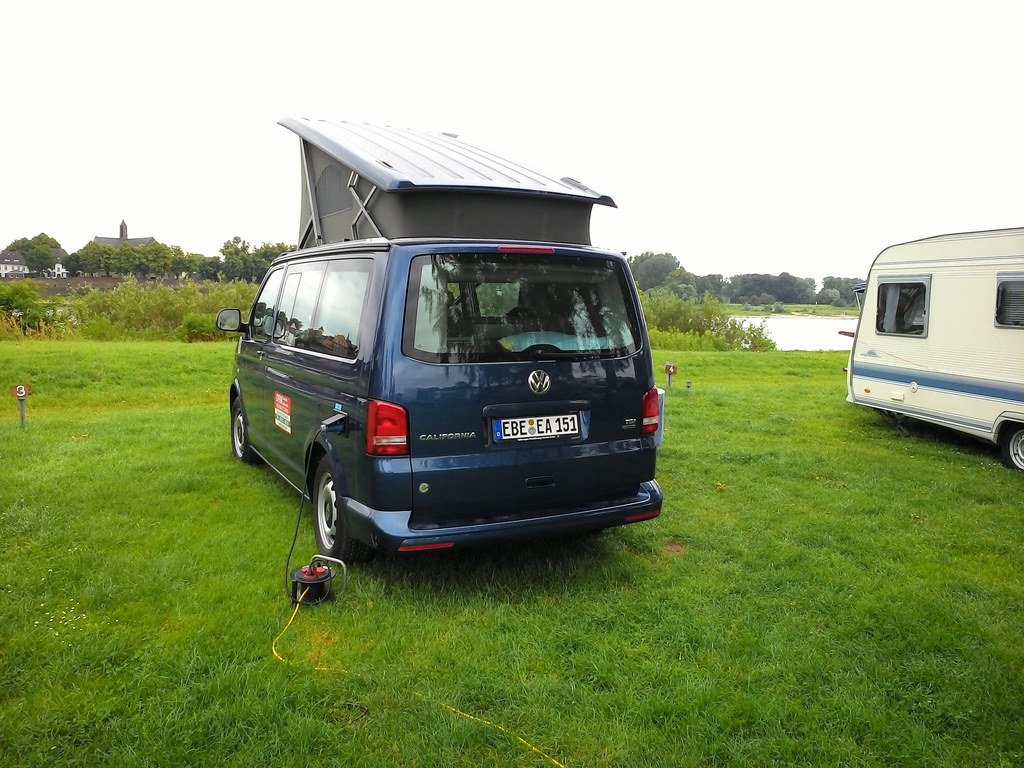
The next morning we woke up to fresh air, a constant panorama of river boats, and the fog of travel lifted – mostly – from our heads.
One thing any PEI Home and School Federation past-president will tell you is that one of the highlights of the official duties of the office is the presentation of the School Bus Driver of the Year awards.
This year I had the pleasure of recognizing Johnny Deagle, a bus driver for Souris Consolidated, with this award. We presented to him at the closing celebration for the school, a rollicking musical event held in the Eastern Kings Sportsplex.
One of Johnny’s many talents is as a musician, so, by chance, I got to present to him just as he was walking off the stage after playing, with a bunch of students, a rendition of Wagon Wheel with words rewritten for the occasion.
Because Oliver and Ethan were along for the trip, they got to come up on stage for the presentation with me.
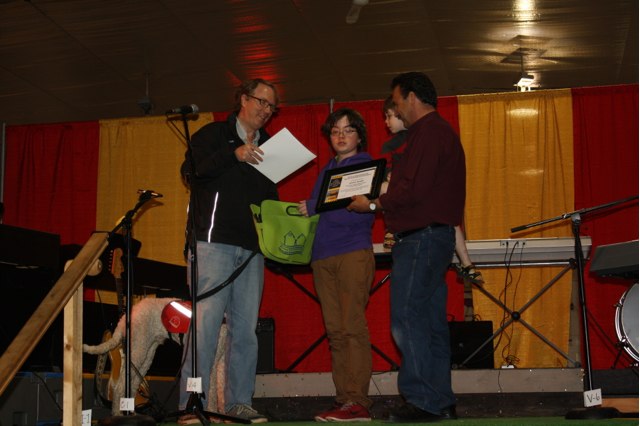
Catherine and her partners Lori Joy Smith and Norma Jean Maclean are opening a show in The Gallery at The Guild on on Wednesday, June 18, 2014.
Each of them has a distinct style, and, beyond that, their show has no unifying theme, at least to their mind.
So what to call it?
They hemmed and hawed and finally came up with “Untitled.”
How to design a poster for a show named “Untitled”?
Cut out the title!
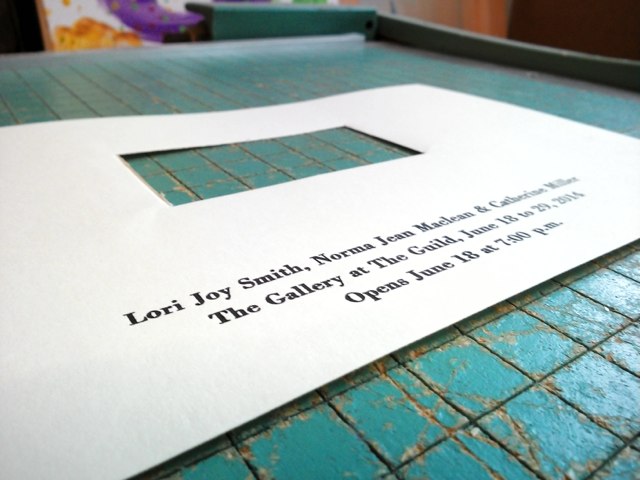
Ironically, Catherine and Oliver and I will be driving our VW camper north from Düsseldorf as the show opens, and we’ll be in Europe for its entire duration.
While I’ve been fiddling with 2014-celebrating type over the past two weeks it’s been more than a few times that I’ve been sharing workspace with the team behind the 2014-celebrating Tall Hat Chronicles, who have been writing and rehearsing here at The Guild. We’ve both found ourselves weaving and dodging to keep out of the way of the all-pervasive Anne and Gilbert, the cast and crew of which, deep into their own rehearsals, seem to ooze from every pore of building.
Having a “Tall Hat Chronicles: Behind the Music” view into the creative process has left me with a deeper appreciation for the fine crafting that goes into making the funny: the show, described for tourismocratic purposes as a “comedic and satirical look at our Island history as it relates to the wider history of Canada and the world,” is, as you might expect, profane and iconoclastic and filled with penises.
And brilliant.
And it is, I can attest, being thoughtfully crafted (I believe I may have heard one of the cast say something like “I don’t think James Palmer would say something like that”) and there were several times when I was at the letterpress and they were reading lines on the sofas around the corner when it was all I could do to contain myself from bursting out in (likely inappropriate) laughter.
I’m looking forward to it. Here’s a taste:
Most Wednesday and Saturday nights this summer at The Guild starting July 2. Get tickets here.
I’m happy to report that my application to the City of Charlottetown Microgrant program for The Social Consumption Project was approved and funded in full (for $900).
I signed an MOU with the City this morning and I’ll begin work on the project in late July, documenting everything I do here.
After I spoke at the Winsloe Lions Club Charter Dinner last Saturday, we were presented with a lovely gift: a framed photo of Catherine, Oliver, Ethan and I walking down the Confederation Trail during the Purina Walk for Dog Guides.
Not only is it a great photo, but it’s the first one of our newly-expanded-by-dog family, and, indeed, one of the few photos we have of our entire family at all, as it’s usually one or the other of us that’s taking pictures.
I was such a nice gesture for them to do this.
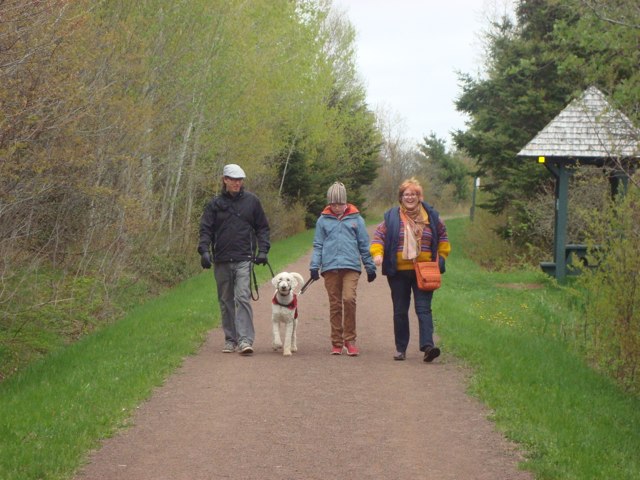
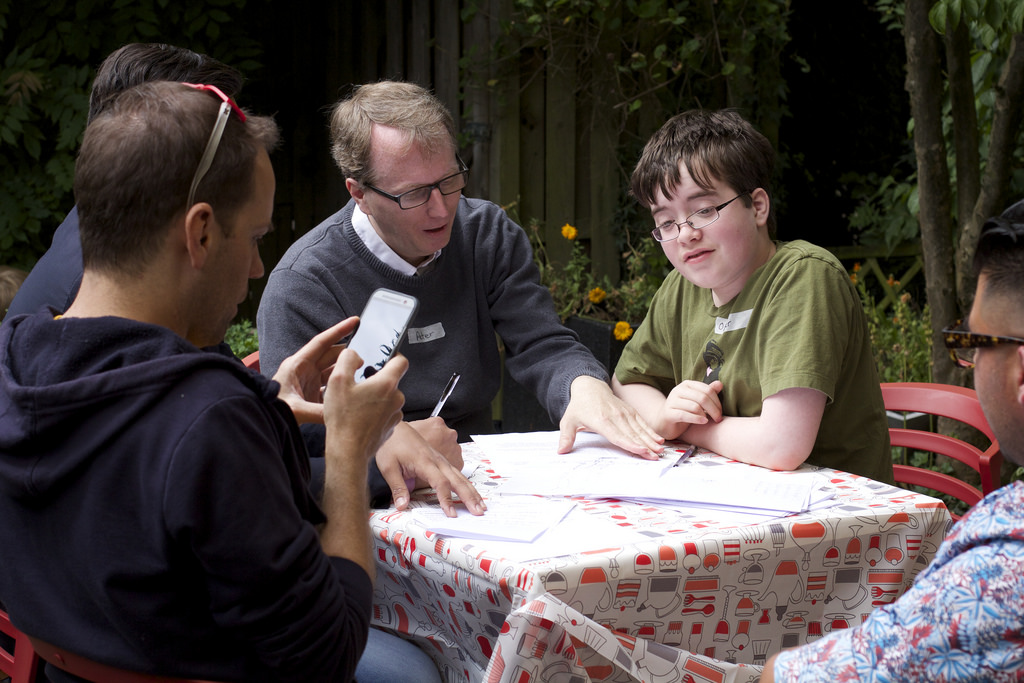
 I am
I am